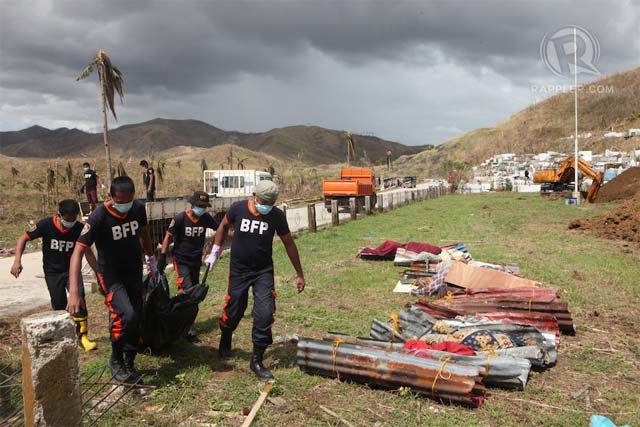SUMMARY
This is AI generated summarization, which may have errors. For context, always refer to the full article.

TACLOBAN CITY, Philippines – The body of a six-year-old British boy was among around 1,000 corpses at a mass grave in the typhoon-ravaged Philippines, his mother said Tuesday, November 19.
Nurse Mary Joy Escalante Ducusin, who also lost her husband in the disaster, sobbed bitterly as she discovered the bag bearing his tiny corpse waiting to be put into the pit in a cemetery above the badly-hit city of Tacloban.
“For several days I kept on searching for him but now I have found him,” she cried. “No words could really explain how painful it is.”
Ducusin and her husband, both Philippine nationals, moved to Britain several years ago to work as nurses in Harlow, near London.
Their only child, Jayro Den, was born there six years ago. He was a British passport holder and grew up speaking only English, she said.
On Tuesday, Ducusin told of how two months after she and her husband had decided to move back to the Philippines to start a new life, the monster typhoon smashed into Tacloban, bringing a destructive storm surge that swamped whole neighborhoods.
“It was so quick,” she recalled. “All I remember was the water rising to the top of my house.”
Jayro Den, Ducusin, her husband and his mother climbed onto the roof, but were blown off by the 315 kilometer (200 mile) an hour winds of Super Typhoon Yolanda (international codename: Haiyan) that smashed through the central Philippines on November 8.
All but 37-year-old Ducusin perished.
“We were carried to the second floor of a house nearby. But I didn’t see my mother-in-law or my six-year-old boy again.”
The 37-year-old said she had scoured the debris left by the monster flood for days in the desperate hope of finding him.
“One of my neighbors sent me a text message saying that they had found a boy, like six years old with the green shirt and the stuffed toy,” she said.
“My baby loves the stuffed toy so much because when he was born, even in the hospital, he got that stuffed toy. He called it Coco.”
The unidentified bodies among the around 4,000 people known to have died in one of the most powerful storms ever recorded are bagged and taken away by firemen on trucks that patrol Tacloban. (READ: Burial of Yolanda casualties must wait – health official)
They are then transported to a cemetery above the city for rudimentary identification by a forensic pathologist, who records the height and gender of each corpse, along with any distinguishing marks, and ascribes a number to each body.
Then they are put into the communal grave. (READ:How to handle corpses during disasters)
On Tuesday, more than 700 putrefying bodies lay piled on top of each other in the grave. Around 250 more were waiting to be processed. Among them was that of Jayro Den.
“I don’t want to think about tomorrow,” said his heartbroken mother.
“I just want to live life day by day, I don’t know where to start, I don’t know where to pick up the pieces.” – Rappler.com
Add a comment
How does this make you feel?
There are no comments yet. Add your comment to start the conversation.